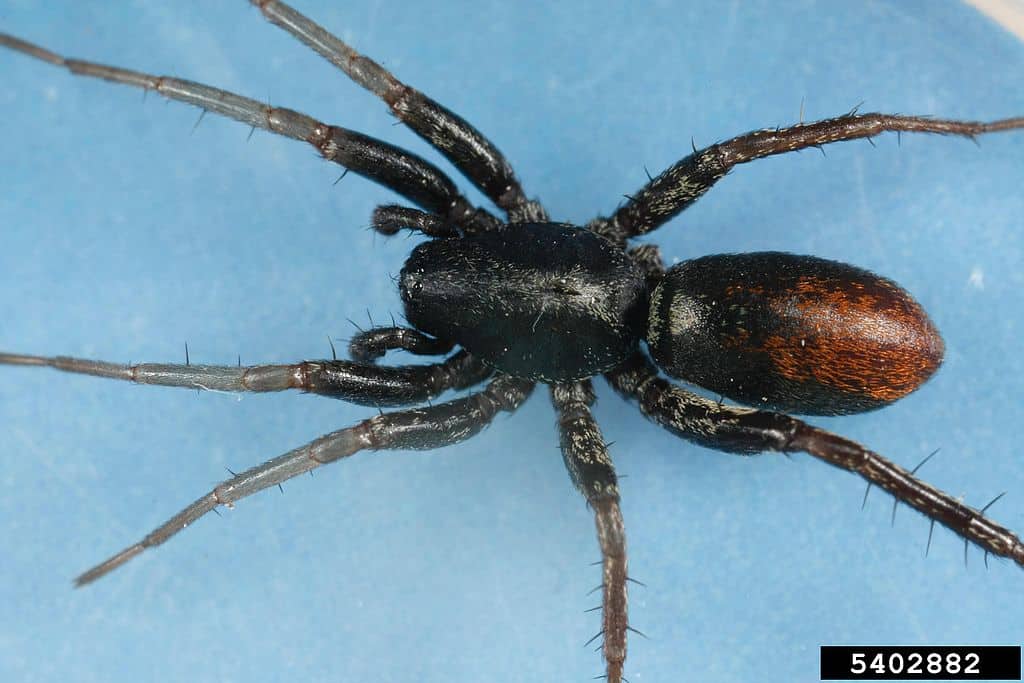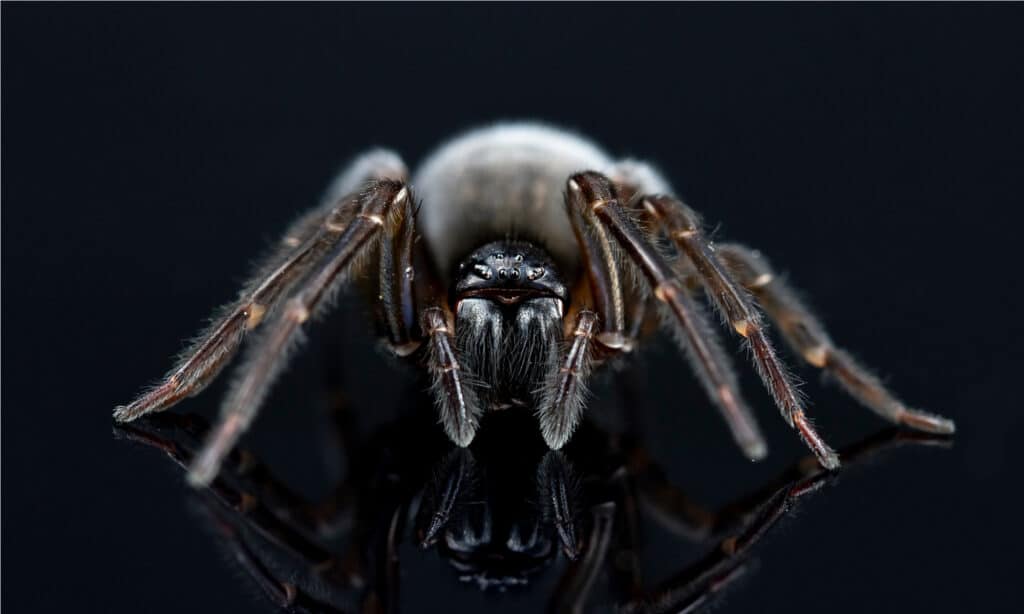Indiana is home to a variety of fascinating wildlife, including species of black spiders that have captured the attention of many nature enthusiasts. These arachnids have a fascinating and intriguing appearance that sets them apart from other spiders.
From their unique behaviors to their distinctive characteristics, there is so much to discover and explore about these amazing creatures. Whether you’re a seasoned spider enthusiast or just curious about the natural world around you, discovering black spiders in Indiana is a journey worth taking.
Bold Jumping Spider (Phidippus audax)

A distinctive feature of the bold jumping spider is the pattern of yellow, orange, or white spots on the top of its abdomen.
©Sari ONeal/Shutterstock.com
Meet the fearless Phidippus audax, also known as the bold jumping spider! This dynamic arachnid belongs to the Phidippus genus and lives in Indiana.
Appearance
The bold jumping spider is a unique species with a distinctive black, hairy appearance. The size of these spiders can vary greatly, with females measuring anywhere from 0.3 to 0.75 inches (8 to 19 mm) and males being smaller at 0.24 to 0.5 inches (6 to 13 mm).
A distinctive feature of this spider is the pattern of yellow, orange, or white spots on the top of its abdomen, with younger spiders often exhibiting an eye-catching orange hue.
Behavior
The bold jumping spider is known for its quick escape tactics when faced with danger from larger animals. These spiders will either jump away or hide in tight spaces to avoid being hunted.
At nighttime, they take refuge in small crevices or cavities, spinning a silk retreat to further protect themselves from predators that rely on touch to locate their prey.
Habitat
These spiders thrive in temperate climates and inhabit diverse areas, including open woodlands, grasslands, chaparrals, and agricultural fields. It is not uncommon to find these spiders living near human settlements.
Eating Habits
Phidippus audax boasts a diverse diet, including other spiders and insects. Studies in cotton fields have revealed that these spiders help control pest populations by preying on boll weevils, tarnished plant bugs, various species of bollworms, and tobacco budworms.
Venom
Luckily, this is a harmless species and poses no threat to humans. This spider is quite shy, so it would more likely retreat than attack. In the rare case of a bite, the venom produced by the spider is not potent enough to cause any harm to humans. At most, you can expect some swelling for a couple of days.
Fun Facts
- Bold jumping spiders live between six months to two years.
- These black spiders have a remarkable vision and use it to locate their prey.
- Bold jumpers do not use webs to catch their food.
Southern Black Widow (Latrodectus mactans)

The southern black widow is visually striking, with a sleek, shiny black exterior and a prominent red-orange hourglass symbol on their abdomen.
©Jeff W. Jarrett/Shutterstock.com
Another resident of Indiana, the southern black widow is a fascinating member of the Theridiidae family, with a widespread reputation. Often referred to as the “black widow,” this spider is notorious for its unique appearance, venomous bite, and male-directed homicidal tendencies.
Appearance
The southern black widow is a visually striking species, with females showcasing a sleek, shiny black exterior and a prominent red-orange hourglass symbol on their abdomen. Conversely, males boast a more subdued appearance, with brown or gray coloring and small, red spotting.
Females measure about 1.5 inches (38 millimeters) in length, while males are roughly half this size.
Behavior
The southern black widow earns its name, “black widow” due to the female’s tendency to consume the male after mating. These spiders generally lead separate lives, coming together only to breed.
Despite their reputation, these spiders are not inherently aggressive and will only bite in self-defense. Humans rarely encounter the elusive male black widows, as they tend to keep to themselves.
Habitat
These spiders love dark and damp places that are not disturbed often. They can be found in window sills, basements, and any cluttered corners of the attic. It’s important to remember that these spiders generally prefer to steer clear of human activity.
Eating Habits
Black widows create signature webs, which they use to trap their prey, including a variety of insects like beetles, grasshoppers, mosquitoes, caterpillars, and flies.
Venom
Humans fear the southern black widow spider for its potent venom that can cause severe and potentially life-threatening effects. Although fatalities from its bites are rare due to the small amount of venom injected, the bite can still cause intense pain, sweating, nausea, muscle stiffness, and breathing difficulties.
Fun Facts
- Black widow spiders can live between one and three years.
- The young spiders have a habit of cannibalism.
- Climate change is leading to an expansion of the black widow’s range.
Red-Spotted Ant Mimic Sac Spider (Castianeira descripta)

The ant mimic spider uses a unique strategy to capture its prey. It mimics the behavior of ants to gain an advantage.
©Joseph Berger, Bugwood.org; University of Georgia / CC BY 3.0, via Wikimedia Commons – License
The red-spotted ant mimic (Castianeira descripta) is a type of true spider that belongs to the Corinnidae family. This species is commonly found in Canada and the United States.
Appearance
The red-spotted ant mimic is distinguishable by its unique appearance, including a black body and legs, with a reddish-brown abdomen and a white line that runs down the center of the carapace. This species of spider has legs that appear to be covered in hair, with a glossy appearance.
Female spiders typically measure between 0.20-0.39 inches in length, while males are proportionately smaller in size.
Behavior
The red-spotted ant mimic spider uses a unique strategy to capture its prey. It mimics the behavior of ants to gain an advantage and increase its chances of success. The spider displays a specific walking style, in which it moves on its hind legs and lifts its front legs as if they were antennae, giving it the appearance of an ant.
This clever mimicry tricks other ants and insects into thinking that the spider is a harmless member of their colony, allowing it to move into position and strike when the time is right.
Habitat
The ant mimic spider lives in various habitats, including shrubs, woods, parks, and stones. This species of spider prefers environments with plenty of vegetation and hiding places where it can conceal itself and hunt for prey.
Eating Habits
This spider is an opportunistic hunter, with ants being its preferred prey. However, it will also feed on other arthropods when the opportunity arises. Unlike many other spider species, this spider does not spin webs to catch its food. Instead, it roams the ground in search of its next meal, relying on its camouflage and stealth to capture its prey.
Venom
The red-spotted ant mimic spider possesses venom primarily used to paralyze its small prey. While the venom is not fatal to humans, a bite from this spider can still be painful and feels like a bee sting.
Fun Facts
- Females use spider silk to create a sac for their eggs.
- They are easily mistaken for ants if not closely examined.
- During inactive periods, adults construct sac-like structures close to ant hills for resting purposes.
Eastern Parson Spider (Herpyllus ecclesiasticus)

The eastern parson spider features a marking that looks like an 18th-century parson’s necktie.
©Fyn Kynd from Searsmont, Maine, United States / CC BY 2.0, via Wikimedia Commons – License
The eastern parson spider, scientifically known as Herpyllus ecclesiasticus, is a type of arachnid found within the Gnaphosidae family. This species is classified as a ground spider and is commonly found in the state of Indiana.
Appearance
The parson spider has a body length of approximately half an inch and is a black or brown hue. The front part of the spider’s body presents a rich chestnut color, while the grayish abdomen showcases a striking white or pink middle stripe pattern. It also has a distinct marking, resembling the necktie of an 18th-century parson.
These spiders have a velvety texture due to the fine hairs that adorn their bodies.
Behavior
This spider is a nocturnal predator, spending its days in hiding spots such as rolled leaves, under bark or stones, or in wooded areas among debris. With their fast-moving behavior, they are capable hunters at night.
The spider constructs a silken retreat to conceal itself during the day, only venturing out under the cover of darkness to look for food.
Habitat
The parson spider is a versatile species that can reside in diverse habitats, including deciduous forests, woodlands, and even human-made structures such as buildings. However, they prefer to reside on the ground, hiding beneath stones, logs, and other natural debris.
Eating Habits
This spider has a diverse diet, feeding on both insects and other spiders. This adaptable predator is a fierce hunter, using its agility and speed to capture its prey and fulfill its dietary needs.
Venom
Bites from the parson spider may result in discomfort and, in rare instances, an allergic reaction with varying symptoms. Such incidents generally occur when the spider becomes accidentally trapped against the skin, such as in clothing or bedding. Therefore, it’s important to be cautious in order to avoid direct contact with the spider.
Their venom is not lethal to humans.
Fun Facts
- Parson spiders live in groups and mate throughout the year.
- The average lifespan is one to two years.
- They move in a zigzag pattern, making it difficult for predators to catch them.
Black Lace-Weaver (Amaurobius ferox)

The spider boasts a marbled appearance, adding to its intrigue.
©IanJHall/Shutterstock.com
The Amaurobius ferox, also referred to as the black lace-weaver, is a nocturnal spider belonging to the Amaurobiidae family and the genus Amaurobius.
Appearance
The Amaurobius ferox has dark coloring, which can range from black to brown, to dark red or tan. The female of this species can measure approximately 0.43 to 0.63 inches in body length, while the males are smaller and slenderer, measuring around 0.31 to 0.39 inches.
The spider boasts a marbled appearance, adding to its intrigue.
Behavior
The black lace-weaver is known for its astonishing mother-spiderling relationship. Initially, females display strong maternal instincts, guarding their spiderlings and providing them with food. The mother provides the babies with unfertilized eggs to eat, and eventually, the spiderlings eat their own mother, a process known as matriphagy!
Habitat
These spiders are primarily found in outdoor habitats such as under stones, in hedgerows, and under logs. Despite their preference for outdoor habitats, the black lace-weaver spider occasionally ventures into buildings, cellars, and outhouses, making them a relatively adaptable species.
Eating Habits
The black lace-weaver is a vital predator of insects and other invertebrates. As a result, these spiders play a crucial role in controlling the populations of these species, serving as key predators in the ecosystem.
Once the spider captures its prey, it injects it with digestive fluids, breaking down the tissues and making it easier to consume. The spider then sucks out the resulting liquid mass, providing the nutrients it needs to survive and grow.
Venom
This spider has bitten humans on a few recorded occasions. Although the bites are painful, the symptoms are typically limited to localized swelling that lasts for around 12 hours.
There have been no reported cases of systemic conditions or long-term health effects from the venom of the black lace-weaver spider.
Fun Facts
- The black lace-weaver is a type of orb-weaver, which means it creates circular webs to trap its prey.
- Their web is strong and durable and can last several months.
- Native to Europe, this spider was first documented in North America in Rhode Island in 1871.
Up Next
The photo featured at the top of this post is © iStock.com/maria72
Thank you for reading! Have some feedback for us? Contact the AZ Animals editorial team.







